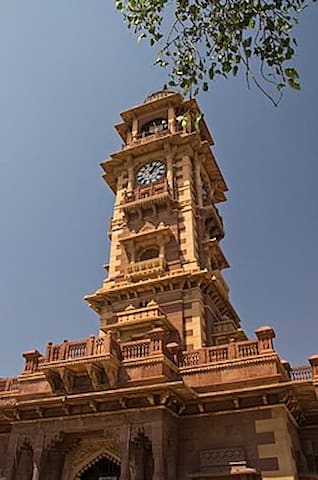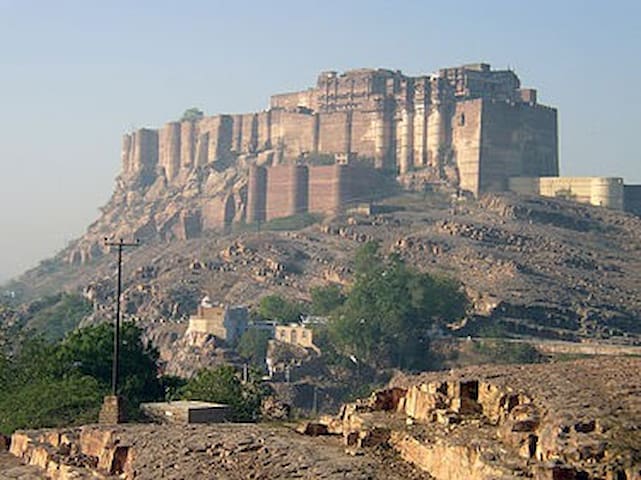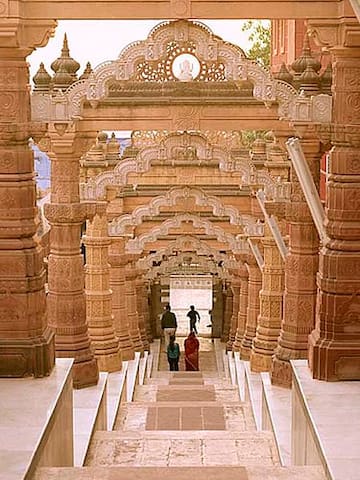Sightseeing
Ghanta Ghar, also known as the clock tower of Rajasthan, is in the Indian city of Jodhpur.[1]
It was built by Maharaja Sardar Singh (1880-1911) from whom the market takes it name. In fact, the tower dominates the entire scenario
Ghantaghar (Tour de l'horloge)
Nai SarakGhanta Ghar, also known as the clock tower of Rajasthan, is in the Indian city of Jodhpur.[1]
It was built by Maharaja Sardar Singh (1880-1911) from whom the market takes it name. In fact, the tower dominates the entire scenario
Built between 1928 and 1943, Umaid Bhawan Palace is a magnificent piece of Rajasthan’s heritage, and a symbol of new Jodhpur. Home of the erstwhile Jodhpur royal family and currently the world’s sixth-largest private residence, the palace has one thing in common with the iconic Taj Mahal at Agra—the palm court marble used in its construction. Perched on Chittar Hill, the highest point in Jodhpur, Umaid Bhawan Palace inspires with exotic views of the historical Blue City, vast sand dunes, and intimidating Mehrangarh Fort. The palace is conveniently located 20 minutes from the airport, close to the main shopping areas, and the Balsamand and Kalyana lakes. The last of the great palaces of India, the property houses a family museum, as well as the resplendent Umaid Bhawan Palace. Set amidst 26 acres of lush gardens, with dancing peacocks and a subterranean Zodiac Pool, the luxury five-star Taj heritage hotel offers 70 utterly breathtaking Art Deco- style rooms and suites. Tantalise your taste buds at Risala with authentic Rajasthani and Indian cuisine. Discover an array of European and Mediterranean delicacies at Pillars, set in a lovely colonnaded veranda. Unwind at the Trophy Bar with its unique hunting-themed décor and vast selection of alcoholic beverages and cigars. Pamper yourself with rejuvenating signature treatments and therapies at the Jiva Grande Spa, or soothe your mind and body with yoga and meditation.Take a heritage walk and relive a fascinating bygone era brought to life through majestic monuments. Soak in the original architecture of a fascinating bygone era and discover the rich history of a palace that has enjoyed actual royal company—Maharani BadanKanwar of Jodhpur having lived here. Stroll through the lush, landscaped Baradari Lawns, perfect for those who have always envisioned a fairy tale wedding. Come, experience luxury like the royals did.
26 recommandé par les habitants
Umaid Bhawan Palace Museum
Built between 1928 and 1943, Umaid Bhawan Palace is a magnificent piece of Rajasthan’s heritage, and a symbol of new Jodhpur. Home of the erstwhile Jodhpur royal family and currently the world’s sixth-largest private residence, the palace has one thing in common with the iconic Taj Mahal at Agra—the palm court marble used in its construction. Perched on Chittar Hill, the highest point in Jodhpur, Umaid Bhawan Palace inspires with exotic views of the historical Blue City, vast sand dunes, and intimidating Mehrangarh Fort. The palace is conveniently located 20 minutes from the airport, close to the main shopping areas, and the Balsamand and Kalyana lakes. The last of the great palaces of India, the property houses a family museum, as well as the resplendent Umaid Bhawan Palace. Set amidst 26 acres of lush gardens, with dancing peacocks and a subterranean Zodiac Pool, the luxury five-star Taj heritage hotel offers 70 utterly breathtaking Art Deco- style rooms and suites. Tantalise your taste buds at Risala with authentic Rajasthani and Indian cuisine. Discover an array of European and Mediterranean delicacies at Pillars, set in a lovely colonnaded veranda. Unwind at the Trophy Bar with its unique hunting-themed décor and vast selection of alcoholic beverages and cigars. Pamper yourself with rejuvenating signature treatments and therapies at the Jiva Grande Spa, or soothe your mind and body with yoga and meditation.Take a heritage walk and relive a fascinating bygone era brought to life through majestic monuments. Soak in the original architecture of a fascinating bygone era and discover the rich history of a palace that has enjoyed actual royal company—Maharani BadanKanwar of Jodhpur having lived here. Stroll through the lush, landscaped Baradari Lawns, perfect for those who have always envisioned a fairy tale wedding. Come, experience luxury like the royals did.
Mehrangarh or Mehran Fort, located in Jodhpur, Rajasthan, is one of the largest forts in India. Built in around 1459 by Rao Jodha, the fort is situated 410 feet (125 m) above the city and is enclosed by imposing thick walls. Inside its boundaries there are several palaces known for their intricate carvings and expansive courtyards. A winding road leads to and from the city below. The imprints of the impact of cannonballs fired by attacking armies of Jaipur can still be seen on the second gate. To the left of the fort is the chhatri of Kirat Singh Soda, a soldier who fell on the spot defending Mehrangarh.
There are seven gates, which include Jayapol (meaning 'victory gate'), built by Maharaja Man Singh to commemorate his victories over Jaipur and Bikaner armies. There is also a Fattehpol (also meaning 'victory gate'), which commemorates Maharaja Ajit Singhji victory over Mughals.
The museum in the Mehrangarh fort is one of the most well-stocked museums in Rajasthan. In one section of the fort museum, there is a selection of old royal palanquins, including the elaborate domed gilt Mahadol palanquin which was won in a battle from the Governor of Gujarat in 1730. The museum exhibits the heritage of the Rathores in arms, costumes, paintings and decorated period.
33 recommandé par les habitants
Fondation du musée Mehrangarh
Fort RoadMehrangarh or Mehran Fort, located in Jodhpur, Rajasthan, is one of the largest forts in India. Built in around 1459 by Rao Jodha, the fort is situated 410 feet (125 m) above the city and is enclosed by imposing thick walls. Inside its boundaries there are several palaces known for their intricate carvings and expansive courtyards. A winding road leads to and from the city below. The imprints of the impact of cannonballs fired by attacking armies of Jaipur can still be seen on the second gate. To the left of the fort is the chhatri of Kirat Singh Soda, a soldier who fell on the spot defending Mehrangarh.
There are seven gates, which include Jayapol (meaning 'victory gate'), built by Maharaja Man Singh to commemorate his victories over Jaipur and Bikaner armies. There is also a Fattehpol (also meaning 'victory gate'), which commemorates Maharaja Ajit Singhji victory over Mughals.
The museum in the Mehrangarh fort is one of the most well-stocked museums in Rajasthan. In one section of the fort museum, there is a selection of old royal palanquins, including the elaborate domed gilt Mahadol palanquin which was won in a battle from the Governor of Gujarat in 1730. The museum exhibits the heritage of the Rathores in arms, costumes, paintings and decorated period.
Rao Jodha Desert Rock Park was created in 2006 to try and restore the natural ecology of a large, rocky wasteland next to Mehrangarh Fort in Jodhpur.
14 recommandé par les habitants
Parc de rochers du désert Rao Jodha
Fort RoadRao Jodha Desert Rock Park was created in 2006 to try and restore the natural ecology of a large, rocky wasteland next to Mehrangarh Fort in Jodhpur.
The Jaswant Thada is a cenotaph located in Jodhpur, in the Indian state of Rajasthan. It was built by Maharaja Sardar Singh of Jodhpur State in 1899 in memory of his father, Maharaja Jaswant Singh II,[1] and serves as the cremation ground for the royal family of Marwar.[2]
The mausoleum is built out of intricately carved sheets of marble. These sheets are extremely thin and polished so that they emit a warm glow when illuminated by the Sun.
The cenotaph's grounds feature carved gazebos, a tiered garden, and a small lake. There are three other cenotaphs in the grounds. The cenotaph of Maharaja Jaswant Singh displays portraits of the rulers and Maharajas of Jodhpur.
16 recommandé par les habitants
Jaswant Thada
The Jaswant Thada is a cenotaph located in Jodhpur, in the Indian state of Rajasthan. It was built by Maharaja Sardar Singh of Jodhpur State in 1899 in memory of his father, Maharaja Jaswant Singh II,[1] and serves as the cremation ground for the royal family of Marwar.[2]
The mausoleum is built out of intricately carved sheets of marble. These sheets are extremely thin and polished so that they emit a warm glow when illuminated by the Sun.
The cenotaph's grounds feature carved gazebos, a tiered garden, and a small lake. There are three other cenotaphs in the grounds. The cenotaph of Maharaja Jaswant Singh displays portraits of the rulers and Maharajas of Jodhpur.
Hop, skip and jump away from Jodhpur, Balsamand Lake is an artificial lake that was built way back in 1159 AD by Balak Rao Parihar as a water reservoir to cater to Mandore. One kilometer long, 50 m broad and 15 m deep; the lake is located amidst a manicured garden full of mango, papaya, pomegranate, guava and plum trees. Jackal and peacock are the prominent guests in the garden. Few years later, an impressive red sandstone summer palace was built on the shores of the lake, which is now converted into a five-star property. Make a point to watch out for pesky monkeys when walking the nature trails.
6 recommandé par les habitants
Bal Samand Lake
Hop, skip and jump away from Jodhpur, Balsamand Lake is an artificial lake that was built way back in 1159 AD by Balak Rao Parihar as a water reservoir to cater to Mandore. One kilometer long, 50 m broad and 15 m deep; the lake is located amidst a manicured garden full of mango, papaya, pomegranate, guava and plum trees. Jackal and peacock are the prominent guests in the garden. Few years later, an impressive red sandstone summer palace was built on the shores of the lake, which is now converted into a five-star property. Make a point to watch out for pesky monkeys when walking the nature trails.
Osian (also spelt Osiyan) is an ancient town located in the Jodhpur District of Rajasthan state in western India. It is an oasis in the Thar Desert. The town is a panchayat village[2] and the headquarters for Osian tehsil. It lies 69 km (43 mi) by road north of the district headquarters at Jodhpur, on a diversion off the main Jodhpur – Bikaner Highway.
Osian is famous as home to the cluster of ruined Hindu and Jain temples dating from the 8th to 12th centuries. The city was a major religious centre of the kingdom of Marwar during the Gurjara Pratihara dynasty.[3] Of the 18 shrines in the group, the Surya Temple, Sun Temple, Sachiya Mata Temple and the Jain temple dedicated to Mahavira stands out in their grace and architecture.
The town was a major trading center at least as early as the Gupta period. It maintained this status, while also being a major center of Hinduism and Jainism for hundreds of year. This came to an abrupt end when the town was attacked by the armies of Muhammed of Ghor in 1195.
Temple Osiyan Mata (Shri Sachchiyay Mataji)
Jodhpur - phalodi megha highwayOsian (also spelt Osiyan) is an ancient town located in the Jodhpur District of Rajasthan state in western India. It is an oasis in the Thar Desert. The town is a panchayat village[2] and the headquarters for Osian tehsil. It lies 69 km (43 mi) by road north of the district headquarters at Jodhpur, on a diversion off the main Jodhpur – Bikaner Highway.
Osian is famous as home to the cluster of ruined Hindu and Jain temples dating from the 8th to 12th centuries. The city was a major religious centre of the kingdom of Marwar during the Gurjara Pratihara dynasty.[3] Of the 18 shrines in the group, the Surya Temple, Sun Temple, Sachiya Mata Temple and the Jain temple dedicated to Mahavira stands out in their grace and architecture.
The town was a major trading center at least as early as the Gupta period. It maintained this status, while also being a major center of Hinduism and Jainism for hundreds of year. This came to an abrupt end when the town was attacked by the armies of Muhammed of Ghor in 1195.
Toorji Ka Jhalra (Toorji’s Step Well) was built in Jodhpur the 1740s by a Queen, Maharaja Abhay Singh’s Consort, continuing an age old tradition that Royal women would build public water works.
7 recommandé par les habitants
Toorji Ka Jhalra Stepwell
Sutharo Ka Bass RoadToorji Ka Jhalra (Toorji’s Step Well) was built in Jodhpur the 1740s by a Queen, Maharaja Abhay Singh’s Consort, continuing an age old tradition that Royal women would build public water works.





